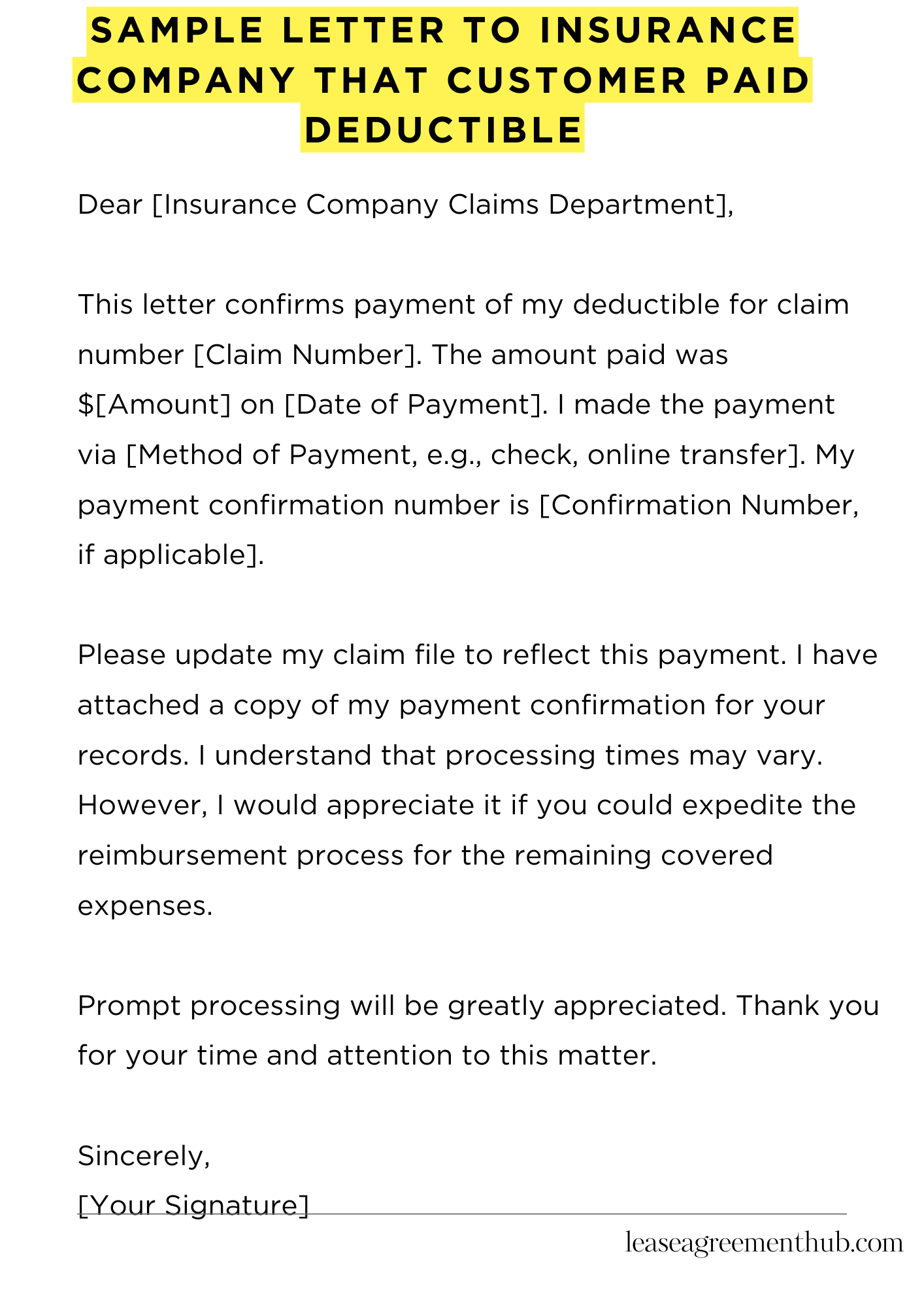Dealing with insurance can be tricky. Sometimes you pay your deductible and need proof for your records. This is where a letter to your insurance company comes in. It confirms your payment and avoids future billing issues.
This article provides sample letters. These samples will help you write your own letter easily. They are ready-made templates. You can adapt them to your specific situation.
We’ll give you different examples. Use the best one that fits your needs. You’ll learn how to write a clear, concise letter quickly.
sample letter to insurance company that customer paid deductible
[Your Name]
[Your Address]
[Your Phone Number]
[Your Email Address]
[Date]
[Insurance Company Name]
[Insurance Company Address]
Dear [Insurance Company Claims Department],
This letter confirms payment of my deductible for claim number [Claim Number]. The amount paid was $[Amount] on [Date of Payment]. I made the payment via [Method of Payment, e.g., check, online transfer]. My payment confirmation number is [Confirmation Number, if applicable].
Please update my claim file to reflect this payment. I have attached a copy of my payment confirmation for your records. I understand that processing times may vary. However, I would appreciate it if you could expedite the reimbursement process for the remaining covered expenses.
Prompt processing will be greatly appreciated. Thank you for your time and attention to this matter.
Sincerely,
[Your Signature]

How to Write a Sample Letter to Insurance Company that Customer Paid Deductible
Understanding Your Insurance Policy’s Nuances
Before crafting your missive, meticulously review your insurance policy. Familiarize yourself with the claims procedure, specifically the section detailing deductible payments and required documentation. This proactive step prevents future complications and ensures a streamlined process. Knowing your policy inside and out is paramount.
Gathering Essential Documentation: A Necessary Precursor
Assemble all pertinent documentation. This includes your insurance card, the claim number (if applicable), proof of payment for your deductible (bank statement, receipt etc.), and any relevant medical bills or repair estimates. Thorough preparation is key to a successful claim. Lack of documentation can significantly impede the process.
Structuring Your Letter for Clarity and Efficacy
Employ a formal yet concise structure. Begin with your contact information and the date. Address the letter to the appropriate claims department. Clearly state your purpose: to confirm deductible payment and request further action on your claim. Use bullet points for clarity where appropriate. A well-organized letter commands attention.
Crafting Compelling Content: The Art of Persuasion
Write in a clear, professional tone. Avoid ambiguity; be precise in your language. Maintain a respectful, yet assertive stance. State the facts objectively, providing incontrovertible evidence of your deductible payment. Remember, your goal is to expedite the claims process, not to engage in protracted correspondence.
Providing Proof of Payment: Exculpatory Evidence
Include a copy of your payment confirmation as an annex to your letter. This irrefutable proof substantiates your claim, eliminating any potential for miscommunication or delay. Consider sending the letter via certified mail for verifiable proof of delivery. This precaution mitigates potential risks of non-receipt.
Maintaining a Paper Trail: A Prudent Strategy
Keep a copy of the letter and all supporting documentation for your records. This comprehensive archive protects your interests and allows for easy reference should any questions arise. Diligent record-keeping is crucial in navigating the complex world of insurance claims.
Following Up: A Necessary Adjunct
If you don’t receive a response within a reasonable timeframe (check your policy for specifics), follow up with a phone call or a polite email. Persistence, while respectful, is often necessary to ensure prompt resolution. Proactive communication safeguards your rights and expedites claim processing.
FAQs about sample letter to insurance company that customer paid deductible
Submitting a letter to your insurance company after paying your deductible is a common process. Understanding how to write an effective letter can ensure a smooth claim resolution.
What information should I include in my letter to the insurance company after paying my deductible?
Your letter should clearly state your policy number, the date of the incident, a brief description of the claim, the amount of the deductible you paid, and a copy of your payment receipt. Include your contact information for easy communication.
What is the best way to send the letter to the insurance company – mail or email?
While many insurers accept emails, it’s generally recommended to send the letter via certified mail with return receipt requested. This provides proof of delivery and helps avoid potential disputes regarding receipt of the documentation. Check your insurance policy or contact your insurer to confirm their preferred method.
Should I include copies of all supporting documents with my letter?
Yes, it’s crucial to include copies of all relevant supporting documentation, such as the receipt for your deductible payment, medical bills (if applicable), repair estimates, and police reports (if applicable). This helps expedite the claim process.
How long should I wait before contacting the insurance company if I haven’t received a response?
Most insurance companies have specific processing times for claims. Check your policy for their typical response time. If you haven’t heard back within a reasonable timeframe (allow a few business days to a week), it’s acceptable to follow up with a phone call or email.
What if my insurance company rejects my claim even after I paid my deductible?
If your claim is rejected, carefully review the reasons provided by the insurance company. Gather any additional documentation that might support your claim. You may need to appeal the decision, potentially involving further communication and possibly contacting your state’s insurance department for assistance.
Related: